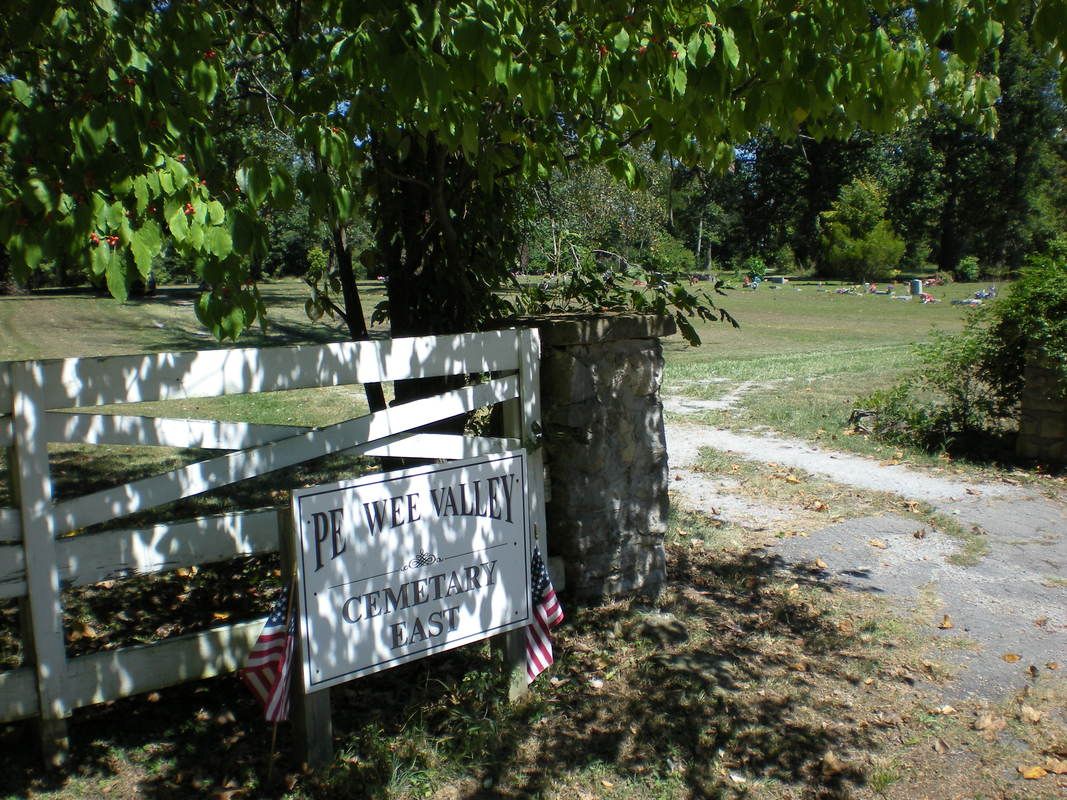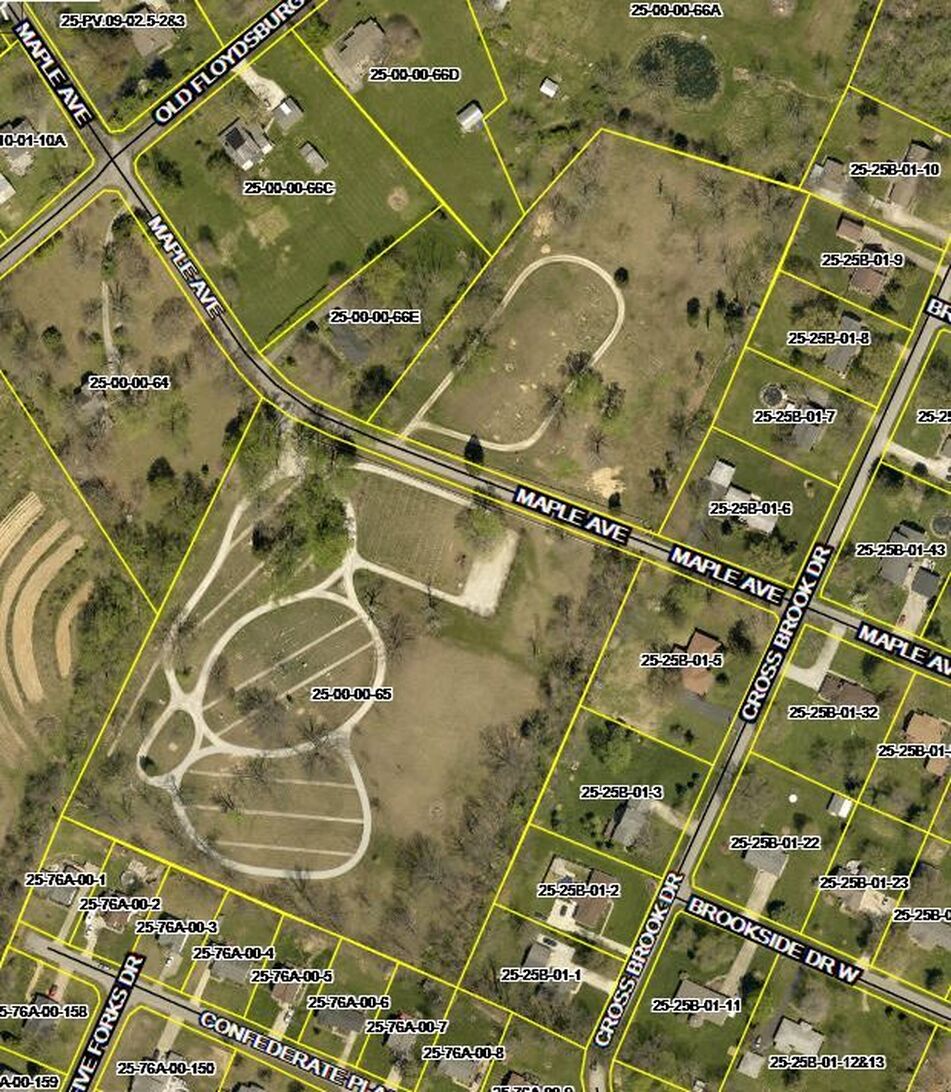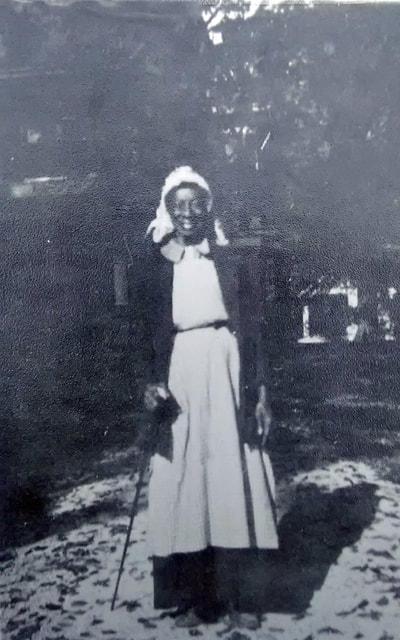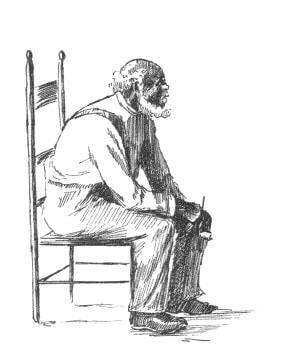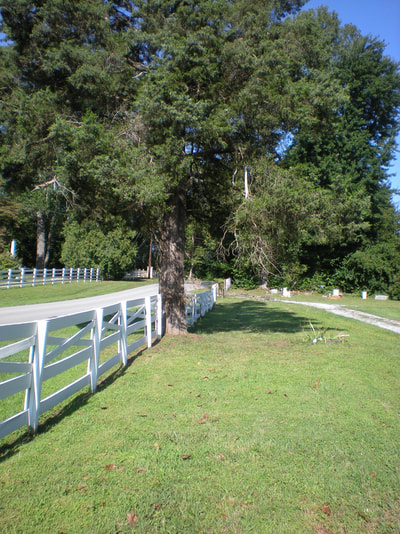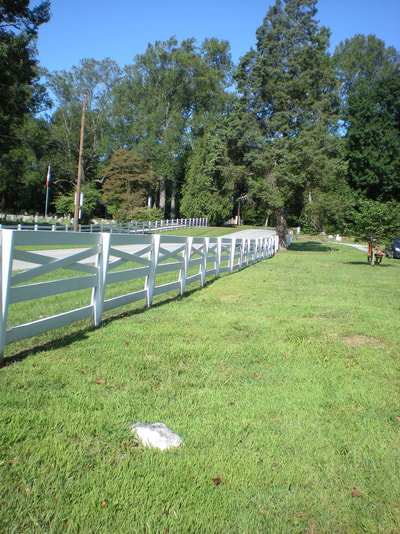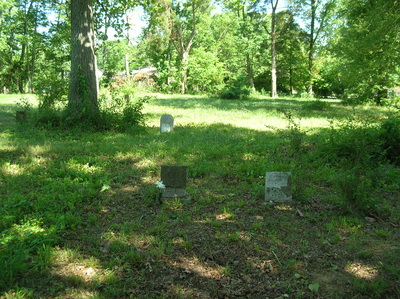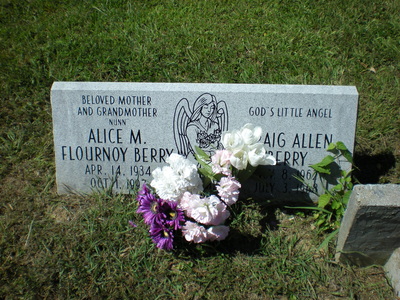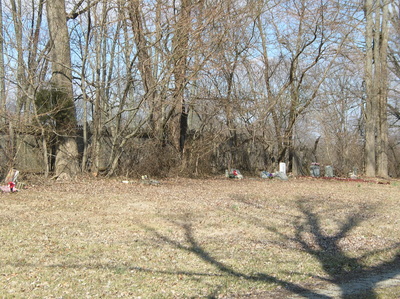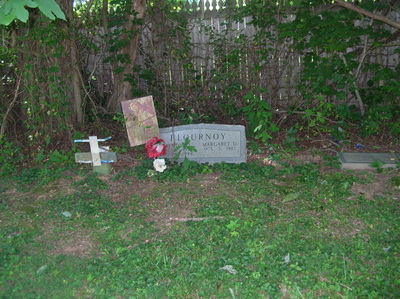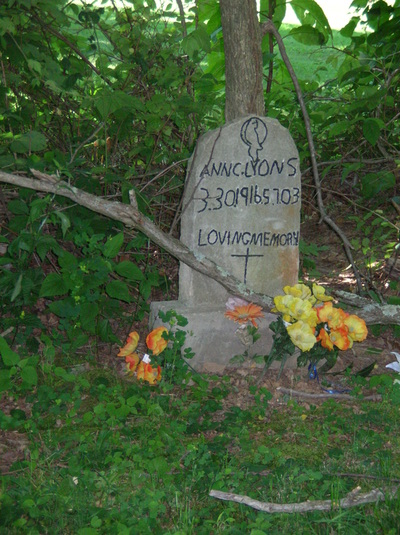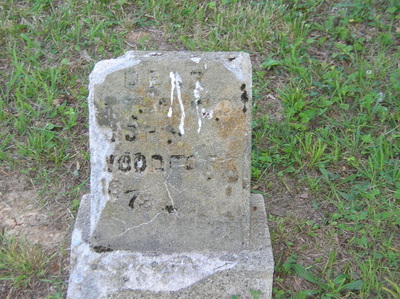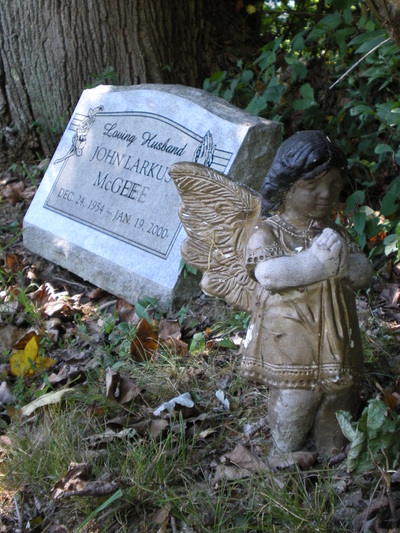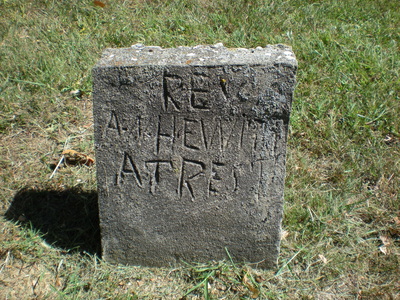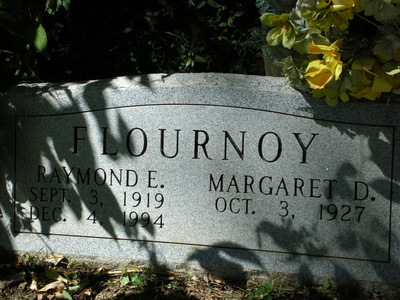Pewee Valley Cemetery East
Pewee Valley Cemetery East, also known as the African-American cemetery, was established when the Pewee Valley Cemetery was established in 1871. Originally, it was an area within the cemetery “toward the N.E. boundary (set aside) for the purpose of a Burial-Place for the colored population of Pewee Valley and the neighborhood.” When Maple Avenue was extended through the middle of the cemetery grounds with a gravel cow path in 1889, it became a physically separate cemetery, but remained under the management of Pewee Valley Cemetery's Board of Directors until 1904.
Recordkeeping for the cemetery has been poor. Pewee Valley Cemetery kept records from 1872 to 1913, but after that, records are sparse. Compounding the problem is that quite a few of the graves were unmarked or had handmade headstones that have either not withstood the test of time or are no longer legible. The records of Stoess Funeral Home in Crestwood, which handled most of the burials at Pewee Cemetery East, were lost in a 1948 fire.
Recordkeeping for the cemetery has been poor. Pewee Valley Cemetery kept records from 1872 to 1913, but after that, records are sparse. Compounding the problem is that quite a few of the graves were unmarked or had handmade headstones that have either not withstood the test of time or are no longer legible. The records of Stoess Funeral Home in Crestwood, which handled most of the burials at Pewee Cemetery East, were lost in a 1948 fire.
According to Pewee Valley Cemetery’s early records, the first lots in the African-American section were sold in 1872 to Mose Buckner and John Hinkle. Since few blacks could afford $6.00 for 16x16-foot lot or $8 for a 16x20-foot lot, most of the plots sold were for individual graves.
Annie Fellows Johnston noted one of the turn-of-the-20th Century practices at Pewee Valley Cemetery East in Chapter 10 of The Little Colonel at Boarding-School:
…There was not a coloured person in the neighbourhood who could have explained why so many graves in the negro cemetery had bottles or fruit-jars placed upon them, inside of which were carefully sealed the whitest of chicken feathers. Undoubtedly they were the relic of some old African fetish…
Annie Fellows Johnston noted one of the turn-of-the-20th Century practices at Pewee Valley Cemetery East in Chapter 10 of The Little Colonel at Boarding-School:
…There was not a coloured person in the neighbourhood who could have explained why so many graves in the negro cemetery had bottles or fruit-jars placed upon them, inside of which were carefully sealed the whitest of chicken feathers. Undoubtedly they were the relic of some old African fetish…
Such practices continued well into the 20th century, and some of the area's African-American residents continued to believe in the power of voodoo, as evidenced by this March 18, 1921 article about the Oldham County trial of Berry Smiser for the murder of his nephew John Booker:
Voodoo Blamed for
Nephew's Murder
________________________
Evidence was introduced at LaGrange yesterday at the trial of Berry Smiser, negro, to show he murdered his nephew, John Booker, after he had been attacked several times.
Booker believed that his uncle "voodooed" him by sprinkling sand around his house. This, it was brought out, was the basis of a trial in Crestwood several years ago, when Booker charged his uncle with "voodooism."
He alleged that one of the "voodoo" signs was a grease spot on the back of his horse. Booker is said to have attacked his uncle March 11 near Pewee Valley. He was killed with an ax. The trial will be resumed today.
Voodoo Blamed for
Nephew's Murder
________________________
Evidence was introduced at LaGrange yesterday at the trial of Berry Smiser, negro, to show he murdered his nephew, John Booker, after he had been attacked several times.
Booker believed that his uncle "voodooed" him by sprinkling sand around his house. This, it was brought out, was the basis of a trial in Crestwood several years ago, when Booker charged his uncle with "voodooism."
He alleged that one of the "voodoo" signs was a grease spot on the back of his horse. Booker is said to have attacked his uncle March 11 near Pewee Valley. He was killed with an ax. The trial will be resumed today.
The Changing Shape of Pewee Valley Cemetery East
The cemetery also appears to have lost some of its original ground. When the land for the public cemetery was purchased in 1871, it was 14.25 acres, more or less. By the 1930s, when the Kentucky WPA surveyed Oldham County, the cemetery was down to 11.2 acres. Pewee Valley Cemetery East also appears to have lost another small piece of ground on its northwest corner between the 1930s and 1953, when the District Map was put together.
The Pewee Valley Historical Society conducted a title search of 405 Maple Avenue, the lot beside Pewee Valley Cemetery East, where the bulk of the missing acreage appears to be. Records show no sale of land from the cemetery to the owners of the lot.
Little Colonel Connections
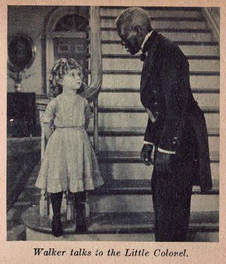
Several people who inspired African-American characters in the “Little Colonel” stories are buried here in unmarked graves.
Walker Hardin
The first is Walker Hardin (1859-1934), the Old Colonel’s manservant in the novels, whose character was played by Bill “Bojangles” Robinson in the 1935 Shirley Temple film, “The Little Colonel.” His burial place was listed on his death certificate when he died on October 23, 1934. Also buried in the cemetery is his son, Walker Hardin, Jr., according to his obituary.
Lucinda Adams
The second is Lucinda Adams (1824-May 18, 1924), who may have inspired the character of Aunt Cindy, The Locust's excellent cook in the novels. In real life, she was married to Henry Adams -- Unc' Henry, who worked as a coachman at Edgewood in the stories -- and was a housewife until after her husband died, sometime between 1880 and 1900.
By 1900, she was working for and living with Nathaniel and Alice Estill Warfield off what is now Rest Cottage Lane. She lived with the Warfields for at least two decades. According to her death certificate, she was 100 years old when she died and she was buried in Pewee Valley Cemetery East. Although the historical society has been unable to locate death records for her husband, he is likely buried here, too.
The second is Lucinda Adams (1824-May 18, 1924), who may have inspired the character of Aunt Cindy, The Locust's excellent cook in the novels. In real life, she was married to Henry Adams -- Unc' Henry, who worked as a coachman at Edgewood in the stories -- and was a housewife until after her husband died, sometime between 1880 and 1900.
By 1900, she was working for and living with Nathaniel and Alice Estill Warfield off what is now Rest Cottage Lane. She lived with the Warfields for at least two decades. According to her death certificate, she was 100 years old when she died and she was buried in Pewee Valley Cemetery East. Although the historical society has been unable to locate death records for her husband, he is likely buried here, too.
Lucinda Adams, Inspiration for Aunt Cindy in the "Little Colonel" Stories
|
Daphne O. Tyler
The third is Daphne, the cook at Edgewood in Two Little Knights of Kentucky. Her character appears to have been inspired by Daphne O. Tyler (May 10, 1859-December 14, 1917). Daphne was born in Shelby County, Ky., to William and Esta Davis Smiser. In 1883, she married Isaac Tyler. Isaac worked for the railroad and by 1900 the family was living in Beard (Crestwood, Ky.) near Fountain and Ida Melone's farm south of Pewee Valley's city limits on Ashwood Avenue. In the 1910 census, Daphne Tyler was listed as living at The Beeches, where she worked as a servant for the Lawton family across Central Avenue from Edgewood. She was also briefly mentioned in a letter written by Mamie Lawton to Annie Fellows Johnston on June 11, 1912. According to her death certificate, she was buried at Pewee Valley Cemetery on December 15, 1917. 
Above, an illustration from "Two Little Knights of Kentucky" showing Unc' Henry in the foreground and Daphne in the rear. Note that Unc' Henry's likeness appears to have been based on his real-life appearance. Right, an illustration by Mary G. Johnston from "Ole Mammy's Torment," published in 1897. Unc' Henry may well have served as Mary Johnston's model, although the man shown appears heavier than Henry Adams and has more facial hair.
|
|
Descendants of Mom Beck
Rebecca Flournoy Porter (the inspiration for the Little Colonel’s mammy “Mom Beck” in the “Little Colonel” stories) isn’t buried here – she was laid to rest in Louisville’s Eastern Cemetery-- but many of her descendants are. Her son, John Hermen Flournoy, purchased a 16x20-foot plot near the gate, south of the roadway, in 1903, when his oldest son Aleck died.
Rebecca Flournoy Porter (the inspiration for the Little Colonel’s mammy “Mom Beck” in the “Little Colonel” stories) isn’t buried here – she was laid to rest in Louisville’s Eastern Cemetery-- but many of her descendants are. Her son, John Hermen Flournoy, purchased a 16x20-foot plot near the gate, south of the roadway, in 1903, when his oldest son Aleck died.
 Rebecca Flournoy Porter, "Mom Beck" in the "Little Colonel" stories, courtesy of descendant Jenny Williams
Rebecca Flournoy Porter, "Mom Beck" in the "Little Colonel" stories, courtesy of descendant Jenny Williams
Grave site listings for the John Hermen Flournoy family, taken from the Oldham County Historical Society’s grave index, include:
- John H. Flournoy
- R. Mollie Booker Flournoy (John Flournoy's wife, Romania ), who taught at the African-American school in Pewee Valley from at least 1916-1924, according to the Notable Kentucky African-Americans Database at the University of Kentucky
- Eugene Flournoy (b. April 12, 1884)
- Ray Flournoy (d. September 25, 1973, age 72)
- Martha Flournoy Hewitt (September (1888-February 1956) and her husband, the Rev. Abel N. Hewitt (June 1876-November 1942), who served as the minister of Sycamore Chapel United Methodist Church in Frazier Town
- Martin C. (August 29, 1896-August 4, 1987) and his wife, Anna Flournoy (1905-1978)
- Etta Rey Flournoy (d. September 14, 1949), presumably John and Romania’s grandchild by their son, John Hermen Flournoy, Jr.
- Raymond E. (September 3, 1919- December 4, 1994) and his wife, Margaret (b. October 3, 1927). He was John and Romania’s grandchild by their son, John Hermen Flournoy, Jr.
- Louise Flournoy Bridwell (April 14, 1898-April 3, 1927), John Herman Flournoy, Sr.'s daughter, who married Mason Bridwell
- Alice Marie Bridwell (1920-1920), John and Romania's grandchild by their daughter Louise
- Mary Flournoy Sutton (1890-1916), John Herman Flournoy, Sr.'s daughter
1967 Cemetery Move to Pewee Valley Cemetery East
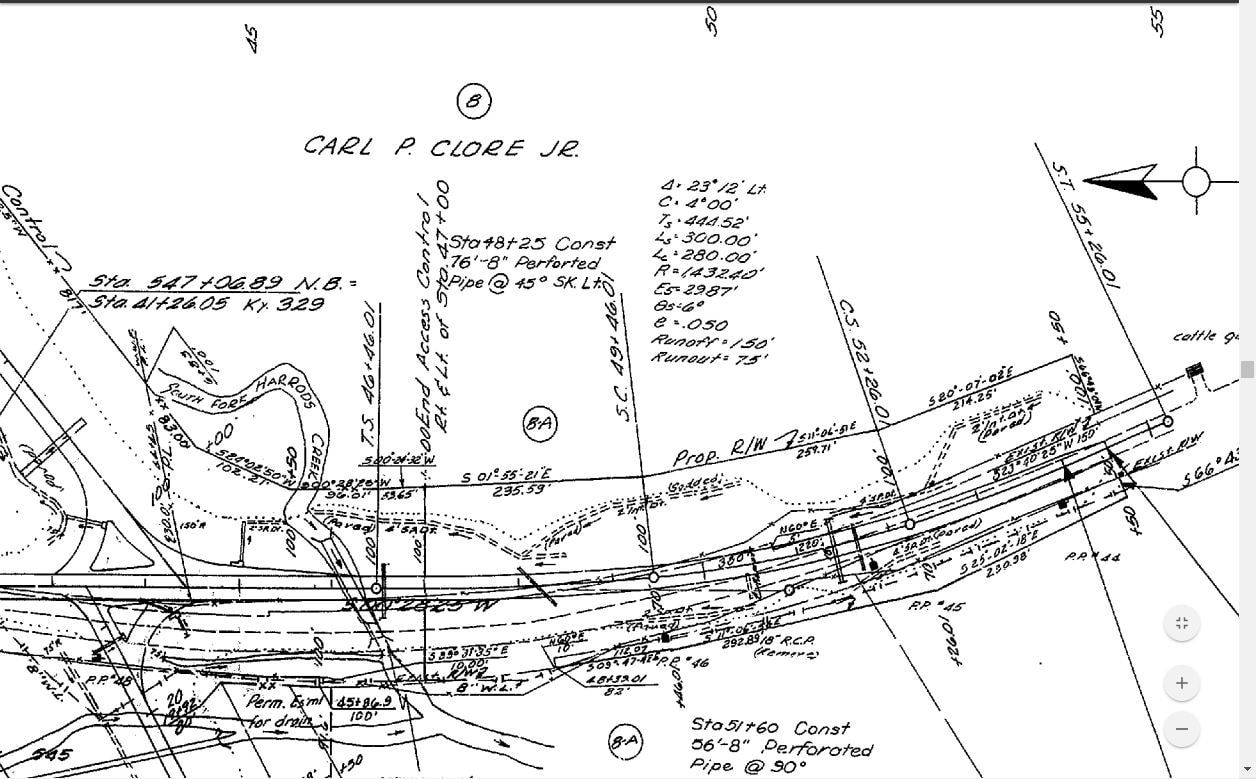
Section of the Clore farm where the cemetery was once located from the Commonwealth of Kentucky Department of Highways Plan and Profile of Proposed State Highway Jefferson-Oldham Counties I-71 (22) 14, microfilmed in 1967. Special thanks to Judy Tingle, Administrative Coordinator, KYTC, Office of Legal Services, for responding to the Pewee Valley Historical Society's open records request.
In 1967, the D.O.T. purchased land for the construction of Interstate 71. That same year, Stoess Funeral Home won a state contract to move 33 graves from a private African-American family cemetery that lay in the interstate's path. The cemetery was located on the George Clore property "... on the South bank of the South Fork of Harrods Creek, about 100 yards from the Creek ... in the median strip where I-71 crosses the creek." It contained the graves of members of the Johnson, Kellar and Dorsey families, and had "... not been used in 30 or 40 years." The graves were marked by field stones or sunken locations in the ground. Stoess re-inters the bodies at Pewee Valley Cemetery East between the cemetery road and the fence line along Maple Avenue.
The bodies were re-interred at Pewee Valley Cemetery between the cemetery road and the fence line along Maple Avenue. Today, that grassy stretch of the cemetery is almost completely devoid of markers, other than a few random stones. The metal markers that were used to mark the graves have disappeared.
The Location of the Johnson, Kellar and Dorsey Graves Today
Unfortunately, more detailed records on the individual identities of the people buried in the cemetery are not available through Stoess Funeral Home or the Kentucky Department of Transportation. The Pewee Valley Historical Society made an open records request to the 5th District DOT and received the following documents from Judy Tingle, Administrative Coordinator, KYTC, Office of Legal Services, on September 20, 2017.
1993 Cemetery Clean Up
The issue of unmarked graves in Pewee Valley Cemetery East has been a topic of discussion for more than two decades. On July 7, 1993, the Courier-Journal ran a story describing the scope of the problem:
Pewee Valley cemetery upkeep falls in the cracks
At first glance, Pewee Valley Cemetery East looks like other small graveyards dotting America's countryside.
Inside the unmarked entrance are two unpaved paths leading to family plots. Small clusters of graves are adorned with artificial flowers and surrounded by freshly cut grass.
But hidden within what appears to be a small wooded area along the African-American cemetery's border are countless forgotten graves, some dating back to the 1800s.
No one knows why such a large portion of the cemetery -- estimated to be 126 years old -- has been neglected.
"There are grave sites there that we won't know who it is until Resurrection Day," caretaker Marvin Durrett said.
Durrett said limited funds and a lack of help have kept him from getting the cemetery cleaned up during his three-year tenure.
Kentucky State Reformatory inmates cut the grass, but the mowing and trimming stops at the edge of the overgrown area, which has been that way as long as 28-year Oldham County resident Ed A. Ford can remember.
"The back end of it is in horrible shape," said Ford, who passes the cemetery on the way to his Brookside Drive home.
"I know it would cost half an arm and a leg to get in there and get that job done," Durrett said, adding that the cemetery's only income is derived from plot sales.
"I've been doing what I can," he said.
"I have to make sure that the graves are dug in the proper places and that no one is buried where they shouldn't be.
"We've tried to get volunteers to help us clean it out."
But Durrett said he has never asked the reformatory -- which also cares for the Confederate Cemetery across the street -- to cut the overgrown area because the previous caretaker told him they would not do such a big job.
In an interview last week, warden Walt Chapleau said he was unaware of the problem.
He acknowledged, however, that the reformatory's landscape crew of 28 minimum-custody inmates is generally limited to small jobs.
"We don't like to get the inmates on chain saws and using axes," he said.
But he said he'd look into the situation.
"We like to do this kind of public relations work. It's good for the community and it's good for us," he said, adding, "We may not be able to do it, (but) we'll have to take a look at it and see."
In the meantime, plots are still being sold, and the 4-1/2-acre cemetery has plenty of space left.
Durrett said African American families in the area favor Pewee Valley Cemetery East.
"Usually, when someone passes, there's no question of where they will be buried," he said.
While the Kentucky State Reformatory was unable to help Pewee Valley Cemetery East with the cemetery cleanup, warden Chapleau approached the Roederer Correctional Complex in LaGrange to see if they could provide a suitable crew. The August 4, 1993 Courier-Journal reported:
... After reading about the abysmal shape of the old section in Neighborhoods last month, warden Walt Chapleu determined that, while the job was too big for reformatory inmates, Roederer might be able to handle it. So he called warden Al Parke, who agreed to work meet with caretaker Marvin Durrett to see what could be done.
"It's one of those types of things that we can help rectify," Parke said, adding that he believes 12 or 13 workers could get the job done in two or three months after the weather cools.
The Roederer boot camp is a new program for non-violent offenders that combines military drill and ceremony with educational and substance-abuse programs.
Durrett said last week that he's elated about the prospect of the cemetery being restored.
"We'll be able to see some of the oldest graves of the black community."
... After reading about the abysmal shape of the old section in Neighborhoods last month, warden Walt Chapleu determined that, while the job was too big for reformatory inmates, Roederer might be able to handle it. So he called warden Al Parke, who agreed to work meet with caretaker Marvin Durrett to see what could be done.
"It's one of those types of things that we can help rectify," Parke said, adding that he believes 12 or 13 workers could get the job done in two or three months after the weather cools.
The Roederer boot camp is a new program for non-violent offenders that combines military drill and ceremony with educational and substance-abuse programs.
Durrett said last week that he's elated about the prospect of the cemetery being restored.
"We'll be able to see some of the oldest graves of the black community."
1997: Pewee Valley Cemetery & Pewee Valley Cemetery East Annexed to the City of Pewee Valley
The November 20, 1997 Oldham Era carried the following story on the City of Pewee Valley's annexation of Pewee Valley Cemetery in its entirety -- both sides, Pewee Valley Cemetery proper and Pewee Valley Cemetery East:
PUBLIC NOTICE
SUMMARY OF
ORDINANCE NO. 5 SERIES
1997-1998
CITY OF PEWEE VALLEY,
KENTUCKY
On November 14, 1997, The Town Council of the Cit of Pewee Valley adopted, enacted, and ordained ORDINANCE 35, SERIES 1997-1998, ANNEXING TO THE CITY OPF PEWEE VALLEY, KENTUCKY, THE FOLLOWING DESCRIBED TRACT OF LAND, UNINCORPORATED, IN OLDHAM COUNTY, KENTUCKY, ADJACENT TO THE PRESENT INCORPORATED LIMITS OF PEWEE VALLEY:
Beginning at the stone Catharine Logans now C. Stoess line and corner to J.F. Russell's heairs now Chas Stoess and running N 71W 24 poles to a stone cor. to Russell's heirs (Now Chas Smith and Bush); thence to S. 26 W 34 6/10 poles to a stone cor. to Bush, thence S 23 W 39 4/10 poles to an ash stump corresponding to Metz and Warren, thence S 70 E 37 poles to a stone in Metz's line, thence N 19 E 72 poles to the beginning, containing 14 1/4 acres more or less, being the same parcel of land purchased August 3rd 1871 by S.S. Schuler from G.W. Curl for the purpose of establishing a Public Cemetery.
This Summary Certified by:
JOHN FRITH STEWART 11-17-97
ATTORNEY AT LAW
Graves Listing
To search for people buried in Pewee Valley Cemetery or Pewee Valley Cemetery East, go to the Oldham County Graves Index compiled by the Oldham County Historical Society. Pewee Valley Cemetery and Pewee Valley Cemetery East are cemetery 148 in the index. Please remember, there are no records for some of the people buried at Pewee Valley Cemetery East listed in the index.
Pewee Cemetery East Photos Taken Prior to a Major Spring Cleanup on April 24, 2014

